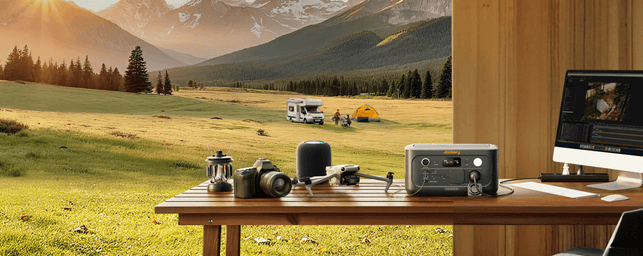Capturing the perfect shot of a wilderness animal is both thrilling and challenging. Unlike studio photography, wildlife photography requires patience, quick reflexes, and the ability to adapt to the unpredictable moments that occur in nature. From elusive birds in flight to animals blending seamlessly into their surroundings, every click of the shutter is an opportunity to tell a story of life in the wild.
In this article, we will share 16 practical tips that will help you refine your skills and become a better wildlife photographer in no time. To make long outdoor sessions easier, consider bringing a solar generator to keep your camera batteries charged. A portable power station ensures your gear stays powered while you focus on capturing the beauty of nature.
1. Research and Plan in Advance
Every great wildlife photo begins long before you step into the field. Why, you may ask? Well, understanding your subject and its environment is crucial for capturing authentic moments.
- Study animal behavior: Learn the habits, feeding times, and migration patterns of your target species. This will help you predict their movements and increase your chances of getting that perfect shot.
- Scout locations: Visit potential spots in advance to understand terrain, lighting, and animal activity.
- Check the season: The wilderness animal you are looking for may only appear in certain regions during particular times of the year, so planning around these windows is essential.
- Gear preparation: Ensure your wildlife cam, lenses, and backup batteries are ready. Even small oversights can cost you a once-in-a-lifetime shot.
2. Practice Patience and Fieldcraft
In wilderness photography, patience is often your most powerful tool. Animals don't follow your schedule; they live by their own rhythms.
- Blend into the environment: Wear neutral or camouflage clothing to avoid startling your subject.
- Stay still and silent: Sudden movements or sounds can send an animal running before you even raise your camera.
- Spend time observing: Sometimes hours of waiting are required to capture a single meaningful image.
- Respect the animal's space: Ethical wildlife photography means never disturbing or endangering the subject.
3. Master the Light: Golden Hours and Beyond
Lighting can transform an ordinary picture into a breathtaking one. Wildlife photography thrives on natural light, and learning to harness it makes all the difference.
- Shoot during golden hours: Early morning and late evening offer warm, soft light that enhances textures and details of wilderness animals.
- Experiment with backlighting: Silhouettes at sunrise or sunset can create dramatic compositions.
- Adapt to harsh daylight: Use shadows creatively or adjust your wildlife cam settings to avoid overexposed images.
- Weather matters too: Fog, rain, or even snow can add atmosphere and depth, turning a simple shot into a story-filled image.
4. Use Camouflage and Blinds
One of the biggest challenges of capturing a wilderness animal is getting close to it without disturbing it. Camouflage and blinds are valuable tools for blending into the environment.
- Wear natural tones: Clothing that matches the landscape helps you remain unnoticed.
- Use blinds or hides: These structures allow you to wait patiently without alarming a wilderness animal.
- Be mindful of scent: In wilderness photography, animals can often smell you before they see you, so avoid strong fragrances.
- Stay low and quiet: Move slowly to blend in with the landscape rather than standing out as a threat.
5. Choose the Right Camera and Lens
Your gear matters when photographing wildlife, especially fast or distant subjects. The right combination ensures you capture every detail without disturbing your target wilderness animal.
- Invest in a wildlife-ready camera: Look for a body with fast autofocus and high burst rates.
- Telephoto lens: Essential for capturing a wilderness animal from a distance while maintaining detail.
- Wide-angle lens: Useful for including landscapes in your wilderness photography, telling a broader story of the scene.
- Stability matters: A sturdy tripod or monopod will minimize blur when using heavy lenses.
6. Don't Underestimate Accessories
Accessories can make the difference between frustration and success in the field. Many photographers overlook their importance. The following are the essentials you must not forget.
- Memory cards: Carry spares with high write speeds for continuous shooting.
- Extra batteries: Cold weather drains power fast, so backups are vital.
- Lens cleaning kit: Dust, fog, or rain can easily compromise your shot.
- Portable power station: Keeping your gear functional on long trips is crucial for wilderness photography.
7. Get a Fast Shutter Speed
Wildlife rarely stays still, and a fast shutter speed ensures sharp, dynamic captures.
- Freeze motion: Capture a bird in flight or a deer leaping without blur.
- Adjust for light: Increase ISO when light is low to maintain speed.
- Practice tracking: Anticipating a wilderness animal's movement lets you stay ahead with your camera settings.
- Use burst mode: Capturing multiple frames per second increases your odds of nailing the decisive moment.
8. Control Your Depth of Field with Aperture
Mastering aperture settings helps you balance focus and artistic style in your shots.
- Isolate the subject: Use a wide aperture (small f-number) to blur the background and highlight the wilderness animal.
- Show the environment: Narrow apertures (large f-number) are great for wilderness photography that emphasizes landscapes.
- Balance light intake: Remember that aperture also affects exposure, so adjust ISO and shutter speed accordingly.
- Creative experiments: Play with aperture to create moods, from dreamy portraits to sharp, detailed scenes.
9. Manage Your ISO
ISO settings control how sensitive your camera is to light, and mastering this is vital for wildlife photography.
- Keep it low when possible: A lower ISO (100–400) produces cleaner images with minimal noise.
- Increase for low light: In dawn, dusk, or forest settings, raise the ISO to maintain fast shutter speeds.
- Balance grain and clarity: A high ISO can introduce noise, so experiment with the settings your camera handles best.
- Adapt on the go: Wilderness animals move unpredictably. So, learn to adjust ISO speedily as lighting changes.
10. Master Your Camera's Autofocus System
Fast and accurate focusing is crucial for achieving sharp results in wilderness photography. Here are some tips that will help you with your autofocus system.
- Use continuous AF (AI Servo/AF-C): This mode is ideal for tracking moving subjects.
- Select the right AF points: Single-point focusing helps lock onto a specific wilderness animal's eye.
- Customize back-button focus: Separating focus from the shutter release gives more control.
- Practice in the field: Understanding your camera's system ensures quick reactions in real encounters.
11. Focus On the Eyes
The eyes often reveal the soul of the subject, making them a crucial element in wildlife photography.
- Prioritize eye sharpness: A wilderness animal looks lifeless if the eyes are blurry.
- Use eye-detection autofocus: Many modern cameras and wildlife cams now offer this advanced feature.
- Highlight expression: Sharp eyes draw viewers emotionally into the photograph.
- Compose around the gaze: Let the direction of the animal's eyes guide your framing.
12. Use Compositional Principles
Composition transforms a snapshot into a striking image, and wilderness photography thrives on strong visual storytelling.
- Rule of thirds: Position your wilderness animal off-center for balance.
- Leading lines: Use natural elements, such as rivers or branches, to draw the viewer's eye.
- Negative space: Leaving room around your subject can emphasize isolation or scale.
- Break the rules: Once you know them, experiment for creative effects.
13. Get Down to Their Level
Perspective is everything in wildlife photography. Shooting at the same level as a wilderness animal makes images more intimate.
- Eye-level shots: Create a sense of connection and respect for the subject.
- Avoid top-down views: Overhead angles often reduce impact.
- Use low positions: You can lie on the ground or use a beanbag for stability.
- Enhance storytelling: A lower perspective immerses viewers in the animal's world.
14. Enhance Your Image in Post-Processing
Even the best shots can benefit from subtle refinement. Editing is an essential part of modern photography, and that is also true for wilderness photography.
- Adjust exposure and contrast: Bring out details lost in tricky lighting.
- Enhance colors naturally: Maintain the authentic look of the wilderness animal and its habitat.
- Crop for impact: Strengthen composition without compromising quality.
- Remove distractions: Small edits can help focus attention on your subject.
15. Prioritize Ethics and Conservation
Wildlife photography is about respecting nature.
- Keep distance: Never stress or endanger a wilderness animal for a shot.
- Avoid baiting or luring: It disrupts natural behavior and can harm animals.
- Support conservation: Share images responsibly to raise awareness of wildlife protection.
- Leave no trace: Practice wilderness photography that preserves habitats for future generations.
16. Pack Safety and Power Gear
Long days in the field require more than just a camera. Being prepared ensures safety and productivity.
- Protective clothing: Weatherproof jackets, boots, and gloves keep you comfortable.
- First aid kit: Essential for any wilderness photography expedition.
- Portable power solutions: A solar generator or portable power station can keep your wildlife cam and batteries charged on extended trips.
- Emergency tools: Maps, GPS devices, and communication devices safeguard against unexpected challenges.
Start Your Wildlife Photography with Jackery's Portable Power Solutions
Wildlife photography often takes you far from the comforts of home into forests, mountains, and remote areas where electricity is scarce. Spending hours waiting to capture the perfect shot of a wilderness animal requires not only patience but also reliable gear that won't fail when you need it most. This is where a portable power solution becomes essential.
From keeping your wildlife cam charged to ensuring your laptop, phone, or drone stays powered, Jackery portable power stations provide the support you need in the wild.
1. Jackery Explorer 240 v2 Portable Power Station
Compact, lightweight, and built for mobility, the Jackery Explorer 240 v2 Portable Power Station is an excellent choice for photographers who prioritize portability. Weighing just 7.94 lbs with a foldable handle, it easily fits into a backpack, making it perfect for wilderness photography excursions. Despite its small size, it packs a 256Wh capacity and can charge up to five devices simultaneously, including your wildlife cam, phone, and GPS.

Its standout feature is its 1-hour flash charging capability, ensuring you are always ready for the next shoot without worrying about dead batteries. With three charging options—AC, solar, or car—you will never run out of ways to keep your equipment powered, no matter where your wildlife photography takes you.
2. Jackery Explorer 1000 v2 Portable Power Station
For more demanding adventures, the Jackery Explorer 1000 v2 Portable Power Station offers higher capacity and power. With a 1070Wh capacity and 1500W output, this portable power station can run heavier equipment, such as laptops, portable air conditioners, or even small refrigerators, making it ideal for extended photography trips. It is 18% smaller and lighter than its predecessor, yet significantly more powerful.

The ultra-fast one-hour charging via Emergency Charge Mode is a game-changer when time is short, while its multiple USB-A and USB-C ports keep your devices ready for action. Whether you are shooting a wilderness animal at sunrise or editing images late at night, the unit ensures your workflow is never interrupted.
Wrapping It Up
Wildlife photography is a journey that blends skill, patience, and respect for nature. From researching your subject and mastering light to focusing on a wilderness animal's eyes and refining shots in post-processing, each tip brings you closer to capturing unforgettable moments.
Alongside technique, preparation is key—having the right gear, adhering to ethical practices, and having dependable power. That's where Jackery's portable power solutions step in, ensuring your wildlife cam and accessories never let you down, even in the most remote locations. With practice, creativity, and the right support, you will not only enhance your wilderness photography skills but also create images that inspire and contribute to conservation.
So, pack your camera, charge up with Jackery, and get ready to capture the wild like never before!









